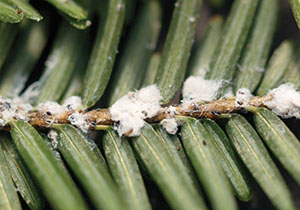IPM a Way Forward for Invasive Species Management
 |
|
The hemlock woolly adelgid (Adelges tsugae) is a tiny insect that feeds on eastern hemlock and produces a woollike protective covering as seen here. Source: Bruce Watt, University of Maine, Bugwood.org. |
If you’re someone who wants to promote the conservation of biodiversity—to sustain the diversity of plants, animals, and other organisms on the planet— and enjoy seeking solutions to complex problems, you might enjoy working on the issue of invasive species.
“Although invasive species seem to be an insurmountable problem,” said Carrie Brown-Lima, director of the New York Invasive Species Research Institute (NYISRI), housed in the Department of Natural Resources at Cornell University, “We can’t just throw in the towel. We can all play a part by taking personal actions to slow the spread of invasive species and prevent new introductions.”
An example of such a personal action might be educating yourself about the hemlock woolly adelgid, an aggressive insect pest that feeds on the sap of hemlock trees and has decimated their populations from North Carolina to southern New England.
“We can learn a lot from IPM and in fact, many of our invasive species are being addressed by IPM programs,” Brown-Lima commented. She notes that invasive species managers think in much the same way as IPM professionals. For example, according to the Northeastern IPM Center website, “IPM is integrated because it brings together, or integrates, a range of biological, organic, cultural, mechanical, and chemical options for pest problems.” That is exactly what her invasive species managers do, she said.
Brown-Lima’s organization serves members of the scientific research community, natural resource and land managers, state government officials, and personnel of state-sponsored organizations. They promote information-sharing, develop recommendations, and create sets of instructions for accomplishing policy-related tasks, or implementation protocols, for research, funding, and management. Their primary objective is to improve the scientific basis of invasive species management.
Another primary goal is to provide invasive species managers, policy makers, and researchers with information. To this end, they have made improvements to their website, adding expert and manager contact databases, blogs, and webinars. They also coordinate an annual conference. In addition, Brown-Lima sees a need for more decision-support tools that would facilitate the use of decision science in invasive species management.
“Prevention is always the best policy,” Brown-Lima said. “Some of the most problematic species here in New York are uncommon in their native range. Non-native species, not yet considered invasive, can become invasive under different climatic conditions or with land-use change.”
Brown-Lima says that the National Invasive Species Council recently updated their national invasive species management plan on its website.* This key document can help newcomers get up to speed with knowledge of invasive species issues.
You could also become an ecological scout. For example, you could join a group in your local area that reports sightings and infestations of the pernicious hemlock woolly adelgid.
Reference
* The National Invasive Species Council Management Plan 2016–2018 can be downloaded from https://www.doi.gov/sites/doi.gov/files/uploads/2016-2018-nisc-management-plan.pdf.
— by CHRIS GONZALES
The Northeastern IPM Center promotes integrated pest management for reducing risks to human health and the environment. If republishing our news, please acknowledge the source (“From Northeast IPM Insights”) along with a link to our website.
